Salinas, CA Pollen and Allergy Report for Summer 2023
Pollen Allergy Trends in Salinas, CA
When is pollen lowest in Salinas, CA?

February
Lowest month total PPM
Avg. PPM
When is pollen highest in Salinas, CA?

March
Highest month total PPM
Avg. PPM
How does pollen in Salinas, CA compare to California?
Salinas has a higher average PPM than the state of California.
Salinas yearly avg PPM:
California yearly avg PPM:
How does pollen in Salinas, CA compare to the USA?
Salinas has a lower average PPM than the USA.
Salinas yearly avg PPM:
USA yearly avg PPM:
Is pollen worse this year in Salinas, CA?
Spring 2023 was worse than spring 2022.
Spring 2023 PPM:
Spring 2022 PPM:
Average PPM in Salinas, CA

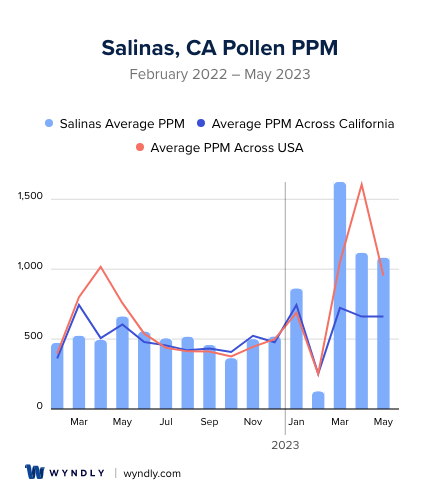
Salinas, CA Pollen and Allergy Breakdown by Month
Grass
When is grass pollen highest in Salinas, CA?
May has the highest grass pollen in Salinas, CA with an average PPM of
When is grass pollen lowest in Salinas, CA?
December has the lowest grass pollen in Salinas, CA with an average PPM of
Tree
When is tree pollen highest in Salinas, CA?
March has the highest tree pollen in Salinas, CA with an average PPM of
When is tree pollen lowest in Salinas, CA?
September has the lowest tree pollen in Salinas, CA with an average PPM of
Weed
When is weed pollen highest in Salinas, CA?
November has the highest weed pollen in Salinas, CA with an average PPM of
When is weed pollen lowest in Salinas, CA?
February has the lowest weed pollen in Salinas, CA with an average PPM of
Salinas, CA Pollen Monthly Breakdown by Pollen Type
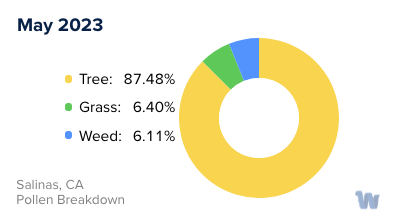
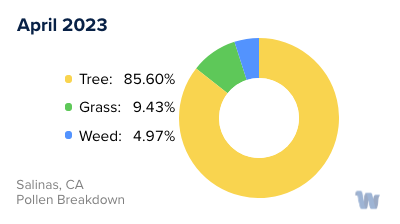

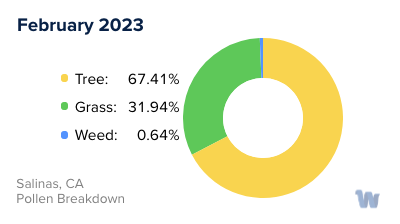



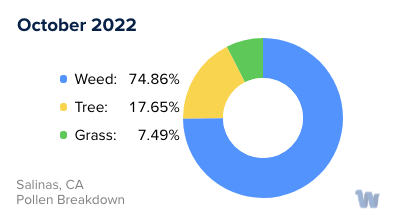


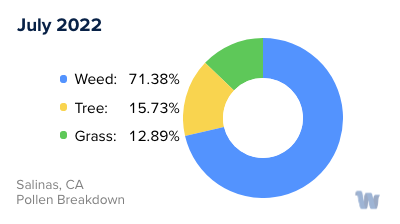


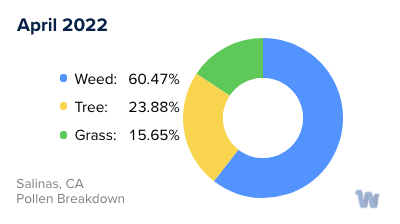
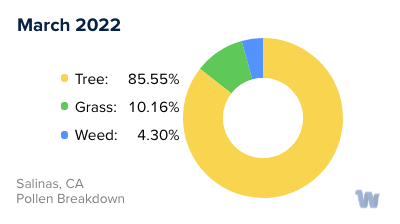

Pollen and Hay Fever in Salinas, CA
Living in the breathtaking city of Salinas, California, with its vibrant fields of lettuce and artichokes, one might also experience an unwelcome companion: pollen allergies, also commonly known as hay fever. Despite its name, hay fever has nothing to do with hay nor is it caused by a fever. It is a response from our immune system to airborne substances, such as pollen.
In Salinas, several types of pollen are prevalent throughout the year, each linked to the blooming cycle of various plants. In the early spring, tree pollen is the main offender. Residents may notice an almost invisible dusting on their cars or windows, a sure sign that trees like oak, pine, and cedar are releasing their pollen into the air.
Moving into late spring and early summer, grass pollen takes center stage. Salinas' vast agricultural fields, coupled with the city's many green spaces, become a source of various types of grass pollen. Timothy grass, ryegrass, and Kentucky bluegrass are among the chief contributors.
In the late summer and fall, weed pollen becomes more prominent. Plants such as ragweed, sagebrush, and nettle start their pollen production, sending out tiny particles that can travel for miles on the wind. Even if these plants aren't in your immediate neighborhood, their pollen can still reach you, triggering the all-too-familiar hay fever symptoms.
Hay fever is more than just a seasonal annoyance. It can significantly impact one's quality of life, leading to sleep disturbance, reduced productivity, and overall discomfort. Despite these challenges, it's crucial to remember that experiencing hay fever doesn't mean you need to lock yourself indoors during these beautiful seasons. With a good understanding of the types of pollen prevalent in each season, one can better anticipate and prepare for the pollen seasons in Salinas, California.
Remember, knowledge is power. So, take heart, fellow Salinans. By understanding the pollen around us, we can better appreciate the beauty of our environment, even if it sometimes makes us sneeze!.

